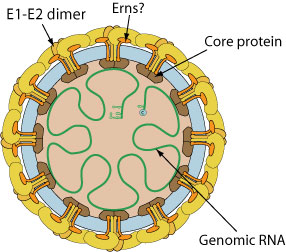Pestivirus (taxid:11095)
VIRION

Enveloped, spherical, about 50 nm in diameter. Mature virions contain three virus-encoded membrane proteins (Erns, E1 and E2) in addition to the core protein.
GENOME
Monopartite, linear, ssRNA(+) genome of about 12 kb. The genome 3' terminus is not polyadenylated, but terminates with a short poly-(C) tract. There is an internal ribosome entry site (IRES) at the 5' end that mediates translation initiation. Duplications, deletions, and other rearrangements are found in most cytopathic pestiviruses isolates.
GENE EXPRESSION
The virion RNA is infectious and serves as both the genome and viral messenger RNA. The whole genome is translated into a polyprotein, which is processed co- and post-translationally by host and viral proteases. There is a leader protease at the N-terminus of the polyprotein, upstream of the capsid protein cistron.
ENZYMES
- RNA-dependent RNA polymerase [NS5]
- FAD capping? [NS5]
- Polyprotein major protease (Peptidase S31) [NS2]
- Self-cleavage N-ter polyprotein (Peptidase C53) [NPro]
REPLICATION
- Attachement of the viral envelope protein E to host receptors mediates internalization into the host cell by clathrin-mediated endocytosis.
- Fusion of virus membrane with host endosomal membrane. RNA genome is released into the cytoplasm.
- The positive-sense genomic ssRNA is translated into a polyprotein, which is cleaved into all structural and non structural proteins (to yield the replication proteins).
- Replication takes place at the surface of endoplasmic reticulum in cytoplasmic viral factories. A dsRNA genome is synthesized from the genomic ssRNA(+).
- The dsRNA genome is transcribed/replicated thereby providing viral mRNAs/new ssRNA(+) genomes.
- Virus assembly occurs at the endoplasmic reticulum. The virion buds at the endoplasmic reticulum and is transported to the Golgi apparatus.
- Release of new virions by exocytosis.
Host-virus interaction
Autophagy modulation
Flaviviridae NS4A and NS4B induces autophagy signaling

 .
.
Innate immune response inhibition
Pestiviruses N(pro) blocks host IRF-3
 .
.
Matching UniProtKB/Swiss-Prot entries
(all links/actions below point to uniprot.org website)5 entries grouped by protein
5 entries
